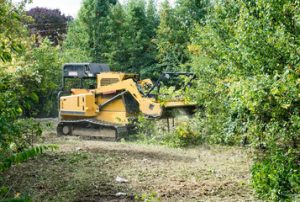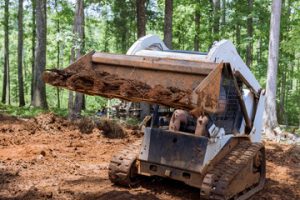Land Clearing Calvert TX is the process of removing vegetation and obstructions from a piece of land. It is crucial for construction, agriculture, fire prevention, and improving property value.

There are several different methods for clearing land, each suited to specific requirements like land size, environment, and project goals. Choosing the right technique ensures efficiency and minimizes environmental impact.
When you need land clearing for your property, it’s essential to take into account the legal ramifications. Depending on the size of the area and type of vegetation, a permit may be required. This process may include submitting an application, providing detailed information about the project, and consulting with local agencies and stakeholders. It can also involve a detailed survey of the land and site conditions, identifying any existing structures or natural features that will remain.
Another important aspect of land clearing is ensuring that it takes the local ecosystem into account. This includes minimizing soil erosion, protecting water quality and preserving wildlife habitats. In addition, it’s essential to consider any ecological impacts that may be caused by clearing and to develop a plan for how the cleared land will be used in the future.
In many areas, it’s not possible to clear large swaths of land without a permit. To avoid any legal issues, it’s best to hire a professional that has experience working on various land types and terrains. They will be able to assess the type of vegetation and determine the best clearing method. This will ensure that the work is done safely and that all legal requirements are met.
When choosing a land clearing service, it’s critical to evaluate providers based on their credentials, equipment, customer reviews, and insurance coverage. It’s also important to obtain multiple quotes to understand the cost range.
Aside from improving the safety of your property by removing debris and dangerous plants, clearing land can make it easier to access buildings and roads. It can also increase the overall value of your home or business by boosting curb appeal. In addition, clearing dead or overgrown vegetation helps prevent wildfires by reducing the amount of material that can burn and spread quickly.
Additionally, it’s important to clear your land before constructing anything, as dense areas provide shelter and food for pests and can be detrimental to the structural integrity of any new construction. This is especially true for buildings and structures built in floodplains or in areas prone to flooding.
Choosing the Right Method and Equipment
As you may already know, there are a variety of land clearing techniques. These methods differ in their effectiveness, time required to complete the project and environmental impact. Choosing the right method and equipment is crucial to ensure your project is completed safely and efficiently. A careful evaluation of the site conditions, available resources and project timelines will aid in selecting the optimal clearing technique.
Whether you need to clear your property for construction or you’re looking to improve its aesthetics, there are many benefits to land clearing. These include fire prevention, which can help reduce the chances of wildfires by eliminating overgrown vegetation, as well as improving the overall look of your property.
The most common clearing method involves the use of heavy machinery to remove trees, bushes and stumps from the site. This can be a fast and efficient method, especially when using specialized attachments such as root rakes and brush grubbers that make it easy to pull out roots without disrupting topsoil. However, this method can also cause damage to the surrounding ecosystem if not conducted properly.
A more environmentally friendly option is to use chemicals such as glyphosate to kill weeds and grasses before they can grow back. This method requires less labor than mechanical clearing but can have a negative effect on nearby flora and fauna, so it should be used sparingly.
Once the land is cleared, it’s important to maintain proper debris management. Debris can be burned (where allowed), chipped on-site or hauled away for disposal. This helps to keep the site clean and safe for construction activities, while also reducing the amount of waste that is sent to landfills.
Additionally, implementing erosion control measures after clearing can prevent soil erosion and protect the land from damage caused by heavy rainfalls. Techniques such as hydroseeding and installing silt fences can help prevent soil erosion, preserve the integrity of the land and prepare it for future landscaping or development.
When evaluating different land clearing companies, it’s important to look at customer reviews and ratings. While it can be tempting to go with the company with the highest star rating, this isn’t always an accurate indicator of quality and reliability. Pay attention to recurring themes in the customer feedback, such as efficiency, thoroughness and punctuality, to get an idea of the company’s level of service.
Safety First
Land clearing can be a dangerous process. It is important to take precautions and work with a team when completing the task. Wearing protective equipment, including hard hats, goggles, and gloves is necessary. It is also a good idea to wear steel-toed boots. Working with heavy machinery such as bulldozers and excavators requires a high level of skill and training to avoid injuries. Regular inspections and follow-up procedures for equipment and machinery are also essential to maintaining a safe work environment.
Before beginning the land clearing process, it is important to survey the area and identify any potential hazards that could impede progress or result in property damage. This includes buried utility lines, unstable soil, and wildlife habitats. Performing these inspections ahead of time will help to prevent costly errors and delays in the construction process.
Another crucial step in the land clearing process is to implement erosion control measures. This helps to stabilize the soil, reduce sediment runoff, and encourage vegetation growth. Implementing these measures will not only benefit the environment but also ensure that the site is prepared for future development.
In addition to implementing erosion control measures, it is important to maintain a clean work site and dispose of debris properly. Failure to do so can lead to safety hazards for workers and damage the equipment used during the clearing process. It is also a good idea to remove any structures that are not needed on the property, such as old sheds or barns. These items can be donated to a scrap wood organization or recycled for other uses.
Considering all of the different steps involved in the land clearing process, it is best to hire professionals for this work. Not only does this save time and money, but it also provides peace of mind that the job will be done correctly and safely. In addition, land clearing companies are well-equipped to deal with any problems that may arise during the process. This is especially helpful for homeowners who do not have the proper equipment or skills to complete the task themselves.
Keeping the Environment in Mind
Land clearing is a necessary process for many projects, from property development to infrastructure expansion. However, it can also have significant environmental impacts if not done responsibly. This is because the removal of trees and other vegetation disrupts the ecosystem, which can lead to soil erosion, changes in water cycles, and loss of biodiversity. It can also contribute to climate change by releasing carbon dioxide into the atmosphere.
There are several ways to minimize the environmental impact of land clearing. One is to choose manual clearing methods, which use hand tools or weed eaters to remove only the specific plants needed for the project at hand. This approach is labor-intensive but eco-friendly, preserving the soil and minimizing disruption to nearby ecosystems. Another method is forest mulching, which turns the cleared debris into a usable material for landscaping purposes and helps reduce erosion. Another option is controlled burning, which can be used to reduce invasive species and return nutrients to the soil. However, these techniques require extensive planning and expert execution to avoid unintended consequences like wildfires and air pollution.
After the land has been cleared, it will need to be graded. This involves levelling the ground to create a suitable surface for construction, agriculture, or landscaping. It is essential that this step is completed properly to prevent erosion and other problems, and it is a good idea to hire professionals to ensure the job is done well.
Once the land has been cleared, it will need regular maintenance to keep it in good condition. This can involve soil treatment, planting of new vegetation, and regular mowing. In addition, clearing away tripping hazards and debris can help increase safety on the site and reduce the risk of injuries caused by falling branches or trees.
Land clearing is a necessary part of many construction and agricultural projects, but it can have negative environmental impacts if not done in a responsible manner. By following the tips above, it is possible to minimize these effects and achieve a successful outcome for any project. For more information on sustainable land clearing, contact an environmental consulting firm.
